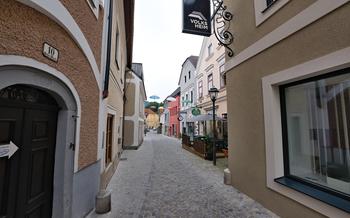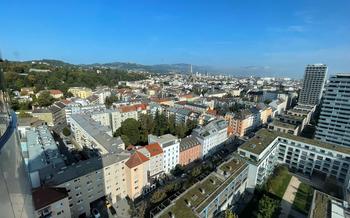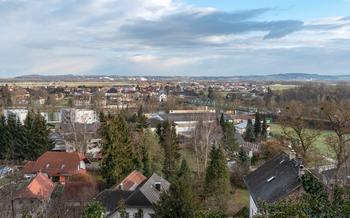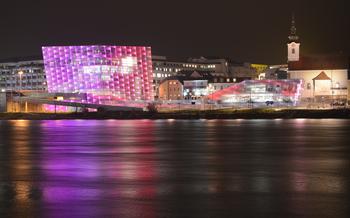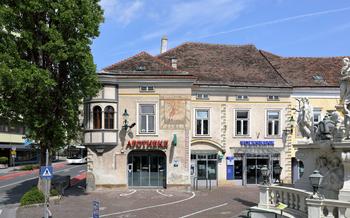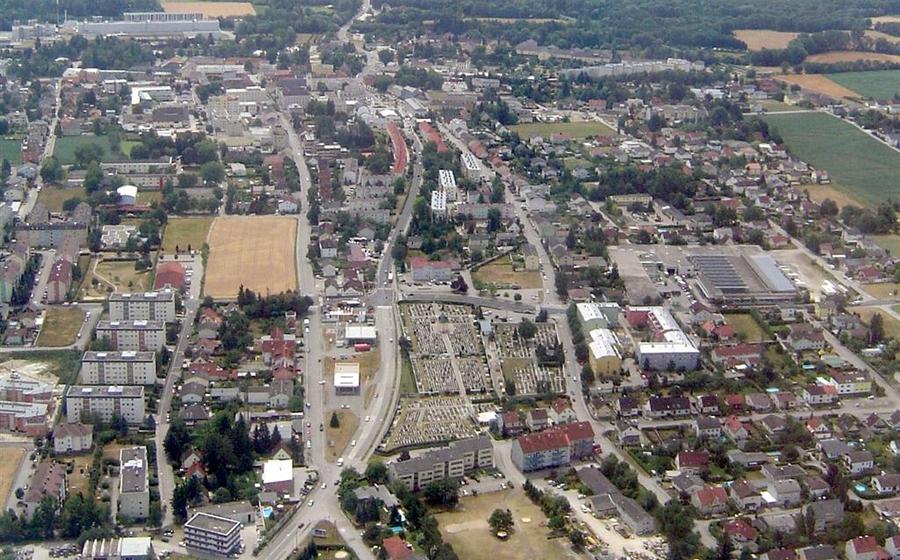
Mauthausen Memorial
- The Mauthausen Memorial Museum
- Getting to the Mauthausen Memorial
- Planning Your Visit to the Mauthausen Memorial
- Things to See and Do at the Mauthausen Memorial
- The Mauthausen Memorial: A Place of Remembrance
- The Mauthausen Memorial and the Local Community
- The Mauthausen Memorial: A UNESCO World Heritage Site
- The Mauthausen Memorial: A Place of Education
- The Mauthausen Memorial: A Place of Reflection
- The Mauthausen Memorial: A Place of Hope
- The Mauthausen Memorial: A Place for Everyone
- The Mauthausen Memorial: A Place to Remember
- The Mauthausen Memorial: A Place to Learn
- Insider Tip: Visiting the Mauthausen Memorial
The Mauthausen Memorial Museum
The Mauthausen Memorial Museum is located on the grounds of the former Mauthausen concentration camp. The museum tells the story of the camp's history and the lives of the prisoners who were held there. The exhibits include photographs, documents, and artifacts from the camp, as well as testimonies from survivors.
The museum is a powerful reminder of the horrors of the Holocaust. It is a place where visitors can learn about the atrocities that were committed at Mauthausen and remember the victims who were killed there. The museum is also a place where visitors can reflect on the importance of tolerance and understanding.
What can visitors learn from the museum?
The Mauthausen Memorial Museum teaches visitors about the history of the camp and the lives of the prisoners who were held there. Visitors can learn about the different types of prisoners who were sent to Mauthausen, the conditions in which they lived, and the work they were forced to do. Visitors can also learn about the camp's role in the Nazi system of concentration and extermination camps.
The museum also teaches visitors about the importance of tolerance and understanding. The museum shows how intolerance and hatred can lead to violence and genocide. It also shows how important it is to stand up against discrimination and injustice.
How much does it cost to visit the museum?
Admission to the Mauthausen Memorial Museum is free of charge. The museum is open to the public from Tuesday to Sunday, from 9am to 5pm.
Getting to the Mauthausen Memorial
Public Transportation: From Vienna, take the train to Linz, and then take the bus to Mauthausen. The journey takes about 2 hours and 30 minutes.
Rental Car: From Vienna, take the A1 motorway to Linz, and then take the B139 to Mauthausen. The journey takes about 2 hours.
Guided Tour: There are a number of guided tours available from Vienna to the Mauthausen Memorial. These tours typically take about 5 hours.
Parking: There is a parking lot available at the memorial. The parking fee is 3 euros.
Time: The journey from Vienna to Mauthausen takes about 2 hours and 30 minutes by public transportation, 2 hours by rental car, and 5 hours by guided tour.
Guided Tours: There are a number of guided tours available in English, German, French, Spanish, Italian, and Russian. The cost of a guided tour is 6 euros.
Planning Your Visit to the Mauthausen Memorial
The Mauthausen Memorial is open to the public seven days a week. The hours of operation are from 9:00 am to 6:00 pm from April 1 to October 31, and from 9:00 am to 5:00 pm from November 1 to March 3
It is recommended to allow at least three hours for your visit to the memorial. This will give you enough time to see the main camp, the quarry, the memorial museum, and the visitor center.
The memorial is wheelchair accessible. There are also wheelchairs available for rent at the visitor center.
Photography and videography are permitted at the memorial, but visitors are asked to be respectful of the victims and their families. Visitors are not allowed to take photographs or videos inside the crematorium or the gas chamber.
There are a number of guided tours of the memorial available. Guided tours are available in English, German, French, Spanish, Italian, and Russian. Guided tours must be booked in advance.
Things to See and Do at the Mauthausen Memorial
The Mauthausen Memorial is a large and complex site, and there is much to see and do. Visitors can explore the main camp, the quarry, the memorial museum, and the visitor center.
The main camp is where the prisoners were housed and where most of the atrocities took place. Visitors can see the barracks where the prisoners lived, the watchtowers that guarded the camp, the crematorium where the bodies of the dead were burned, and the gas chamber where many prisoners were killed.
The quarry is where the prisoners were forced to work. It is a vast and desolate place, and it is easy to imagine the suffering that the prisoners endured here. Visitors can see the tools that the prisoners used, the piles of rocks that they were forced to move, and the memorials that have been erected to honor the victims.
The memorial museum is located in the former camp commandant's office. It houses a collection of artifacts from the camp, including photographs, documents, and personal belongings of the prisoners. Visitors can learn about the history of the camp, the lives of the prisoners, and the atrocities that were committed here.
The visitor center is located at the entrance to the memorial. It provides information on the memorial and its history, as well as maps and brochures. Visitors can also purchase tickets for guided tours of the memorial.
The Mauthausen Memorial: A Place of Remembrance
The Mauthausen Memorial is a place of remembrance for the victims of the **
The Mauthausen Memorial and the Local Community
The Mauthausen Memorial has had a significant impact on the local community. The memorial has brought increased tourism to the area, which has helped to boost the local economy. In addition, the memorial has raised awareness of the history of the Holocaust and the suffering of the victims of the camp. This has led to a greater understanding of the Holocaust and its impact on the local community.
However, the memorial has also faced some challenges in its relationship with the local community. Some members of the community have been critical of the memorial, arguing that it is a reminder of a dark period in the history of the region. Others have expressed concerns about the impact of the memorial on tourism, arguing that it has led to an increase in crime and vandalism.
Despite these challenges, the memorial has been a valuable resource for the local community. The memorial has provided a space for people to learn about the history of the Holocaust and to remember the victims of the camp. It has also helped to promote peace and reconciliation in the region.
The local community can support the memorial in a number of ways. One way is to visit the memorial and learn about its history. Another way is to donate to the memorial or to volunteer their time. The local community can also help to promote the memorial by talking about it to their friends and family and by encouraging others to visit the memorial.
The Mauthausen Memorial: A UNESCO World Heritage Site
The Mauthausen concentration camp was designated a UNESCO World Heritage Site in 20This designation recognizes the camp's historical significance and its role in educating about the Holocaust. It also provides the memorial with additional protection and support.
UNESCO World Heritage Site
UNESCO World Heritage Sites are places of outstanding universal value that are recognized for their cultural, historical, or natural significance. The Mauthausen concentration camp meets this criteria because it is a well-preserved example of a Nazi concentration camp. It is also a powerful reminder of the atrocities committed by the Nazi regime during the Holocaust.
Benefits of Being a UNESCO World Heritage Site
Being a UNESCO World Heritage Site has several benefits for the Mauthausen Memorial. First, it provides the memorial with increased visibility and recognition. This can help to attract more visitors to the memorial and raise awareness of its history. Second, the designation provides the memorial with additional financial support. This can be used to improve the memorial's facilities and educational programs. Third, the designation helps to protect the memorial from development and destruction.
Challenges of Managing a UNESCO World Heritage Site
Managing a UNESCO World Heritage Site is a complex and challenging task. The memorial must balance the need to preserve the site's historical integrity with the need to make it accessible to visitors. The memorial must also deal with the challenges of managing a large number of visitors, as well as the challenges of dealing with the often-difficult emotions that visitors experience when visiting the site.
The Mauthausen Memorial: A Place of Education
The Mauthausen Memorial is committed to educating visitors about the Holocaust. The memorial offers a variety of educational programs, including guided tours, lectures, and workshops. These programs are designed to help visitors understand the history of the camp, the experiences of the prisoners, and the broader context of the Holocaust.
The memorial also has a research library that is open to the public. The library contains a wealth of information on the Holocaust, including books, articles, and archival documents. Visitors can use the library to learn more about the camp, the prisoners, and the Holocaust.
The Mauthausen Memorial is an important resource for teaching about the Holocaust. The memorial's educational programs and resources can help students and teachers to learn about this dark chapter in history. The memorial can also help to promote critical thinking and discussion about the Holocaust.
One of the challenges facing the memorial in its educational mission is the fact that the Holocaust is a difficult and often disturbing topic. The memorial must be sensitive to the needs of visitors, especially those who are survivors or descendants of survivors. The memorial must also find ways to present the history of the camp in a way that is accurate and informative, without being overly graphic or sensational.
Despite these challenges, the Mauthausen Memorial is committed to providing visitors with a comprehensive and accurate education about the Holocaust. The memorial's educational programs and resources are essential tools for teaching about this important topic.
The Mauthausen Memorial: A Place of Reflection
The Mauthausen Memorial is a place where visitors can reflect on the horrors of the Holocaust and the suffering of the victims. The memorial's exhibits and displays provide a powerful reminder of the atrocities that were committed at the camp. Visitors can learn about the history of the camp, the lives of the prisoners, and the methods of torture and execution that were used. The memorial also provides a space for visitors to reflect on the broader implications of the Holocaust and its impact on the world.
There are many ways that visitors can use the memorial to reflect on the past. They can walk through the camp grounds and see the barracks, watchtowers, and crematorium. They can read the stories of the prisoners and learn about their experiences. They can also participate in educational programs and workshops that are offered by the memorial.
The Mauthausen Memorial is a challenging place to visit, but it is an important place to visit. It is a place where visitors can learn about the Holocaust, reflect on the past, and honor the victims of the camp.
The Mauthausen Memorial: A Place of Hope
Despite the horrors that occurred at Mauthausen, the memorial offers a message of hope for the future. By remembering the victims and learning from the past, we can help to prevent such atrocities from happening again. The memorial also promotes peace and reconciliation by bringing people together from all over the world to learn about the Holocaust and its impact.
There are many ways that visitors can contribute to the memorial's mission of hope. They can share their stories and experiences with others, support educational programs, and donate to the memorial. Visitors can also help to promote peace and reconciliation by working to build bridges between people of different cultures and backgrounds.
The Mauthausen Memorial is a place where visitors can learn about the Holocaust, remember the victims, and work towards a better future. It is a place of hope and reconciliation, where people from all over the world can come together to learn from the past and build a better future.
The Mauthausen Memorial: A Place for Everyone
The Mauthausen Memorial is a place for everyone, regardless of age, background, or ability. It is a place to learn about the Holocaust, to remember the victims, and to reflect on the past. The memorial is also a place of hope, offering a message of peace and reconciliation.
Why is it important for everyone to visit the Mauthausen Memorial?
The Mauthausen Memorial is an important place for everyone to visit because it tells the story of one of the darkest chapters in human history. The memorial helps us to remember the victims of the Holocaust and to learn from the past so that we can prevent such atrocities from happening again. It is also a place where we can come together as a global community to promote peace and reconciliation.
What can people of all ages and backgrounds learn from the memorial?
The Mauthausen Memorial offers a variety of educational programs and resources for people of all ages and backgrounds. Visitors can learn about the history of the camp, the lives of the prisoners, and the impact of the Holocaust on the local community. The memorial also offers a variety of guided tours, which are available in several languages.
How can the memorial be made more accessible to people with disabilities?
The Mauthausen Memorial is wheelchair accessible, and there are a number of ramps and elevators to help visitors with disabilities get around the site. The memorial also offers a variety of audio guides, which are available in several languages, and there are a number of benches and resting places throughout the site.
How can the memorial be made more welcoming to people from different cultures and backgrounds?
The Mauthausen Memorial is a welcoming place for people from all cultures and backgrounds. The memorial offers a variety of educational programs and resources in several languages, and there are a number of staff members who are fluent in multiple languages. The memorial also hosts a variety of events throughout the year, which are open to the public.
The Mauthausen Memorial: A Place to Remember
It is of paramount importance to remember the victims of the Mauthausen concentration camp to honor their lives, acknowledge their suffering, and ensure that their stories are never forgotten. The memorial stands as a poignant reminder of the atrocities that occurred during the Holocaust, serving as a testament to the resilience and indomitable spirit of those who endured unimaginable horrors.
The memorial plays a crucial role in keeping the memory of the victims alive by preserving the site, collecting and sharing their stories, and organizing educational programs. Through its exhibitions, guided tours, and online resources, the memorial provides visitors with a deeper understanding of the camp's history and the lives of those who were imprisoned there.
Visitors can honor the victims of the camp by paying their respects at the memorial site, learning about their experiences, and reflecting on the profound impact of the Holocaust. They can also contribute to the memorial's mission by sharing their knowledge with others, supporting educational initiatives, and advocating for tolerance and understanding.
Challenges facing the memorial in its mission to remember the victims include the passage of time, the fading memories of survivors, and the rise of Holocaust denial and distortion. To address these challenges, the memorial continues to document and preserve the experiences of survivors, conduct research, and engage with a diverse audience to ensure that the memory of the victims remains alive for generations to come.
The Mauthausen Memorial: A Place to Learn
The Mauthausen Memorial is a place where visitors can learn about the history of the Holocaust and the Mauthausen concentration camp. The memorial offers a variety of educational programs, including guided tours, lectures, and workshops. Visitors can also learn about the Holocaust through the memorial's exhibits, which include artifacts, photographs, and documents.
The Mauthausen Memorial is an important resource for teaching about the Holocaust. The memorial's educational programs and exhibits help visitors to understand the history of the Holocaust and its impact on the lives of millions of people. The memorial also provides a space for visitors to reflect on the Holocaust and its legacy.
One of the challenges facing the memorial in its educational mission is the fact that the Holocaust is a difficult and often disturbing topic. The memorial must find ways to present the history of the Holocaust in a way that is both accurate and respectful. The memorial must also be sensitive to the needs of visitors who may be affected by the material.
Despite the challenges, the Mauthausen Memorial is an essential resource for teaching about the Holocaust. The memorial's educational programs and exhibits help visitors to understand the history of the Holocaust and its impact on the lives of millions of people. The memorial also provides a space for visitors to reflect on the Holocaust and its legacy.
Insider Tip: Visiting the Mauthausen Memorial
- Be prepared: The Mauthausen Memorial is a large and complex site, so it is important to be prepared before your visit. Do some research on the history of the camp and the lives of the prisoners so that you can better understand what you are seeing.
- Take your time: The Mauthausen Memorial is a place of remembrance and reflection, so it is important to take your time and absorb the atmosphere. Don't rush through the exhibits or the grounds.
- Be respectful: The Mauthausen Memorial is a sacred place for many people, so it is important to be respectful of the victims and their families. Be quiet and respectful when visiting the memorial, and avoid taking photos or videos of the victims or their belongings.
- Talk to a survivor: If you are able, talk to a survivor of the Mauthausen concentration camp. This is a unique opportunity to hear firsthand accounts of the horrors of the Holocaust.
- Make a donation: The Mauthausen Memorial is a non-profit organization, and it relies on donations to operate. If you are able, please make a donation to the memorial to help support its important work.

